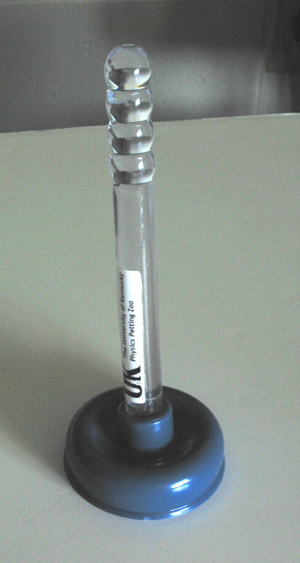
Instructions for:
Make a Vacuum
Make a Vacuum is a normal toilet plunger (unused of course). When you push it down on a smooth surface, you squeeze air from the rubber bulb, and when you pull back, the pressure inside this bulb is greatly reduced. The difference in pressure causes the plunger to "stick" to the surface.

Normal atmospheric air at sea level exerts an average force of 14.7 pounds on each square inch of surface it touches. This means that normal kitchen table, four feet square (or 2304 square inches) experiences a force of 33,868.8 pounds (about 17 tons) on its tabletop. This is balanced however, by an equivalent force, caused by air pushing likewise on its bottom.
When considering a plunger on a flat surface, when you pull on the handle, you decrease the pressure inside the rubber bulb by a few pounds per square inch. Assuming that the areas of the inside and outside surfaces of the bulb are roughly equal, this difference in pressure can create quite a force on the plunger. If we estimate the surface area of the bulb at 15 square inches, the outside air exerts a force of 220.5 pounds on the top of the plunger. The air inside the plunger bulb, at a pressure of around twelve psi, exerts a force on the inner walls of the plunger of only 180 pounds. This means essentially, that around forty pounds of force, due to the difference in air pressure, push the plunger onto the smooth surface. This effect is commonly known as suction.
These diagrams outline the above concept:
Copyright 2004 Straley/Pinney - The University of Kentucky Physics Petting Zoo